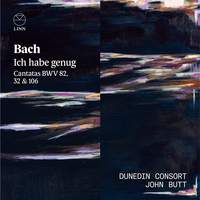Interview,
John Butt on Bach cantatas
 John Butt and his Dunedin Consort are among today's most acclaimed interpreters of Bach, with recent recordings of the Christmas Oratorio, Magnificat and both Passions all winning plaudits. Their latest release combines the 'funeral cantata' known as the Actus Tragicus BWV106 with the yearning Liebster Jesu, mein Verlangen BWV32 and the deservedly ever-popular Ich habe genug BWV82, with soloists Joanne Lunn and Matthew Brook.
John Butt and his Dunedin Consort are among today's most acclaimed interpreters of Bach, with recent recordings of the Christmas Oratorio, Magnificat and both Passions all winning plaudits. Their latest release combines the 'funeral cantata' known as the Actus Tragicus BWV106 with the yearning Liebster Jesu, mein Verlangen BWV32 and the deservedly ever-popular Ich habe genug BWV82, with soloists Joanne Lunn and Matthew Brook.
I spoke to John about the music on this album, and its particular resonance now in times that remain troubled and difficult for many.
For the last 18 difficult months there has been an elephant in the room for virtually every artistic undertaking. Given the subject matter of these cantatas – the consolation of the anxious soul in the face of mortality – the question seems particularly unavoidable here: Is this album to some degree a response to the Covid-19 pandemic?
Yes, very much so, although we didn’t want to make a huge point about it – we had wanted to record Matthew Brook in Ich habe genug for some time and we also thought about more Bach for Joanne Lunn.
The Actus Tragicus makes use of quotations from Lutheran chorales which would have had particular connotations for listeners in Bach’s time. Do you think some of the impact of the music is lost on contemporary (global, increasingly secular) audiences, who generally don’t have an entire hymnal half-memorised?
Well, the impact of the type the original listeners would have felt is of course partly lost, but that is not to say that other forms of impact might not affect us today. Particularly clear in those sections with chorales is the counterpoint, not just of musical lines, but of ideas and feelings. One could argue that such a texture invites a sense of nuance and ‘simple/direct complexity’ that exercises us intellectually and emotionally (and even, at times, physically in terms of the movements we can model within our bodies). Many of us might have learned this from various later forms of music, and in ways that Bach’s original audience might not yet have experienced.
The similarity between the opening motifs of Ich habe genug and Erbarme dich from the St Matthew Passion is unmistakeable – and all the more striking as the latter work is thought to have premiered only a few months after the cantata. Do you think this is just a coincidence, or was Bach intentionally drawing some kind of link between the two pieces?
I don’t think Bach’s mentality was such that he would consciously have linked one piece to another (as Wagner might have done with Leitmotifs across the component operas of the Ring). But, if our modern forms of musical memory are anything to go by, it’s certainly possible that he might have had the gesture ‘in his head’ for a few months, almost without realising it. The simple historical explanation is of course that the rising minor 6th was often seen by theorists as an ‘exclamatio’ – i.e. an emotionally charged gesture that could be applied to any expression of heightened emotion. Why was it emotionally charged? Perhaps because it was banned in the traditional counterpoint of the 16th century, which many people still studied (and indeed study today) as a foundation for newer forms of music. I also suspect that the traditional avoidance of this interval lies in the fact that it is likely to cross one of the register breaks in the voice and thus puts the singer into a slightly vulnerable vocal space; this vulnerability could serve emotional expression extremely well.
Kirsty Matheson’s apt cover image for the album – sombre, yet shot through with light – is also entitled “Ich habe genug”. Was this artwork conceived as part of the album?
Yes, absolutely – Kirsty became very well known in the classical music community during lockdown since for a long while she was producing one painting to match a piece of music every day. We bought three of them (Dido and Aeneas, Petrushka and Schoenberg’s first Chamber Symphony). It was decided early on in production that we’d commission this cover — which she painted in response to the first edit of our recording.
You mention the likely popularity of Ich habe genug in Bach’s time. The popular imagery of these cantatas is dominated by the incredible, and sustained, speed of their composition and it’s therefore tempting to assume that they were “single-use” works. How much do we know about their extended life, beyond the specific Sundays for which they were written?
We can tell a lot with many Bach cantatas from the surviving sets of performing parts (we are much more lucky here with Bach than with Handel, for whom very few parts survive). Musicologists have been able to date subsequent performances from additional parts or from amendments made by later copyists (or Bach himself). In the case of Ich habe genug we even have transpositions for different voices. Perhaps the most telling evidence for its popularity in the Bach household is the fact that the second aria is found in one of Anna Magdalena’s music books, transposed for soprano performance.
Joanne Lunn, Katie Bray, Hugo Hymas, Robert Davies, Matthew Brook, The Dunedin Consort, John Butt
Available Formats: CD, MP3, FLAC, Hi-Res FLAC



